
| KIT: | Monogram 1/48 F9F-5P Panther |
| KIT #: | ? |
| PRICE: | $13.95 MSRP |
| DECALS: | Two options |
| REVIEWER: | Tom Cleaver |
| NOTES: |

| HISTORY |
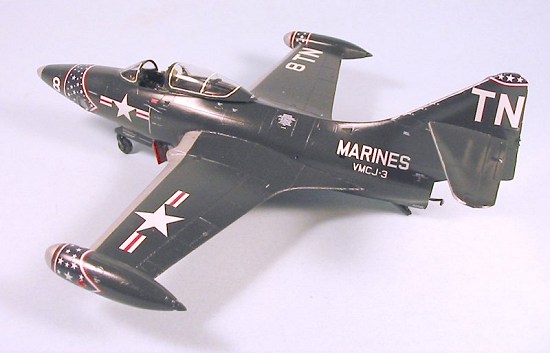 The Navy began a program of creating fleet photo-reconnaissance aircraft
through the modification of contemporary fleet fighters, beginning with the
F4F Wildcat. The idea was that an unarmed aircraft with the performance of
the leading fleet fighter would have maximum survivability on operations.
The Navy began a program of creating fleet photo-reconnaissance aircraft
through the modification of contemporary fleet fighters, beginning with the
F4F Wildcat. The idea was that an unarmed aircraft with the performance of
the leading fleet fighter would have maximum survivability on operations.
The F9F Panther series saw this policy continue, with the creation of the F9F-2P Panther, which had an extended nose with two side-looking cameras and three photo-mapping vertical cameras replacing the four 20mm cannon. The uprated F9F-5 also saw 34 aircraft modified to F9F-5P standard. These were distributed to various fleet fighter squadrons, and also equipped Marine Photo-Recon squadron VMJ-3, which was operating in Korea. These photo-recon Panthers were used by the Marines up until 1957, when they were replaced by F9F-8P Cougars. One of these aircraft, which was operated by VMCJ-3 at El Toro MCAS in the years following the Korean War, is on display in non-flyable condition at The Air Museum, Planes of Fame, in Chino, California.
| THE KIT |
Modelers expected Monogram to release the photo-recon F9F-5P shortly after the original release of the F9F-5 in 1990. Given that the modification was minimal, involving only the two fuselage parts and some extra clear parts, it seemed like a no-brainer. But then, managing to miss the no-brainers during the late 1980s and 1990s is why Monogram is in the condition it is nowadays. I remember seeing the sprues for this kit on the Revell-Monogram/Pro-Modeler display table at the 2001 IPMS-USA Nationals in Chicago, where the representative assured me the kit would be released before the end of the year.
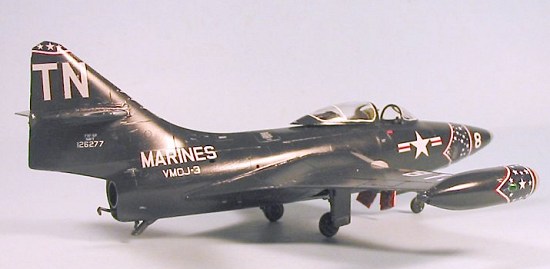 Better late than never!
Better late than never!
As anyone would have guessed, there are five new pieces in the F9F-5 kit: two fuselage halves with the extended nose, suitably modified for the camera windows, and three pieces of clear plastic for said camera windows. Past that, it is the old reliable F9F-5 kit, right down to the inclusion of the underwing ordnance - which would be completely inappropriate for this version. The kit still has raised panel lines, but I have to say - having just taken a look at the surviving F9F-5P out at Chino this past weekend a few hours after obtaining the kit - that these raised panel lines do not detract from a realistic recreation of the original. Personally, my opinion is that any modeler who thinks a model is “unacceptable” for not having recessed panel lines is a modeler who has likely never been within spitting distance of a real airplane, many of which have lapped panels that look far more like raised lines than they do recessed lines; petitely-done raised lines, like these, are entirely acceptable.
The kit decals provide markings for two Marine Panthers - one from VMJ-3 based at MCAS Miami in 1954, and one from VMCJ-3 at MCAS El Toro in 1956. I will likely do the latter, since it is the survivor now on display at Chino.
| CONSTRUCTION |
As anyone familiar with the original Panther kit knows, this is an easy build, in fact so easy it would be a good first model for someone re-entering the hobby after a long absence, or someone deciding to build their first plastic model.
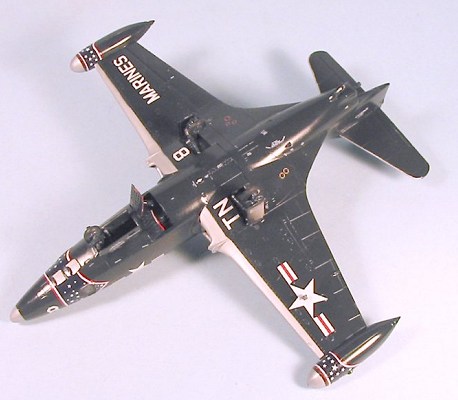 The wing parts were warped, no doubt result of the quick-and-dirty
production run on this kit. I heated a pot of water just to the boiling
point, dipped the parts and straightened them out; you may find the same
problem on your kit.
The wing parts were warped, no doubt result of the quick-and-dirty
production run on this kit. I heated a pot of water just to the boiling
point, dipped the parts and straightened them out; you may find the same
problem on your kit.
Other than the wing warp, there were no other problems with the kit, which I assembled per the instructions with no difficulty. I did like the addition of decals for the instrument panels in the cockpit, which definitely improve the look of things over the original issue, which had to be hand-painted.
Do be sure to put weight in the nose before sealing up the fuselage. I used three “cannon ball” fish weights in the extreme nose, which solved all problems.
I used Mr. Surfacer 500 on all the seams - centerline of the fuselage, upper and lower wing-to-fuselage, wing leading edge and tip tanks. The surface detail is the very petite raised variety, and I merely replaced what was lost in sanding the seams by scribing with a #11 X-acto.
The only place where the seams were bad was the attachment of the lower camera ports. I painted these black inside, masked off the glass, and attached them. I first sealed the seams with CA glue, sanded that smooth, then applied Mr. Surfacer to cover over the seams.
| COLORS & MARKINGS |
Painting:
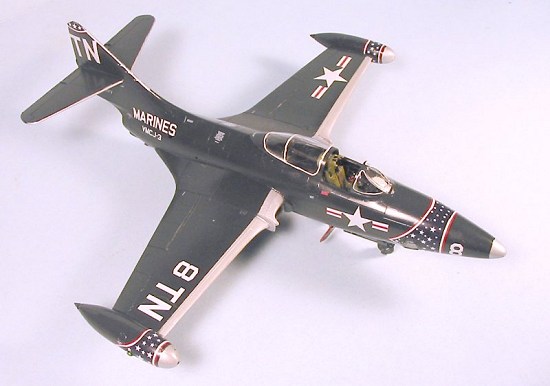 I
airbrushed the leading edge of the wings, the tip tanks, nose tip and tail
surfaces with Floquil “Old Silver.” After letting that cure thoroughly, I
masked off these areas and painted the rest of the model with Gunze-Sangyo
“Midnight Blue.” When that was dry, I gave the model a coat of Model Master
Metalizer Sealer.
I
airbrushed the leading edge of the wings, the tip tanks, nose tip and tail
surfaces with Floquil “Old Silver.” After letting that cure thoroughly, I
masked off these areas and painted the rest of the model with Gunze-Sangyo
“Midnight Blue.” When that was dry, I gave the model a coat of Model Master
Metalizer Sealer.
Decals:
I used the decals for the VMCJ-3 airplane, inasmuch as this is the only F9F-5P left, and is currently on display at The Air Museum, Planes of Fame, in Chino, California in the jets museum.
The decal sheet for the nose marking has clear film in the area that will go around the camera port. I found it easy to apply the decals and get them correctly positioned leaving this film in place. Once the decal had set, I cut that away with the trusty X-acto. The kit decals are all nicely opaque and thin, and go down with no problems under a coat of Micro-Sol.
| FINAL CONSTRUCTION |
I attached the landing gear, put the ejection seat in the cockpit, and attached the canopy in the open position. Photos of this airplane show it to be well-maintained and very clean during its time at El Toro, so I did not weather it further.
| CONCLUSIONS |
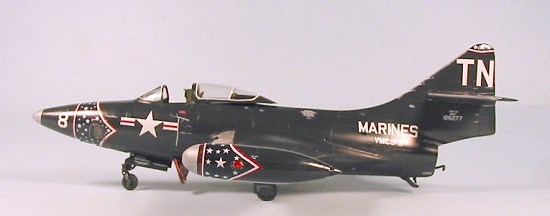 An excellent kit that presents no problems whatsoever. The Panther is my
favorite jet, probably from having seen the Blue Angels perform in them
during their final Panther year when I was only a wee aeronut - that and
listing “The Bridges at Toko-ri” as my all-time favorite airplane movie.
This F9F-5P makes up into a very attractive model of a little-known variant
of the Panther, that looks good sitting on my USN Jets shelf next to its
more combative brother.
An excellent kit that presents no problems whatsoever. The Panther is my
favorite jet, probably from having seen the Blue Angels perform in them
during their final Panther year when I was only a wee aeronut - that and
listing “The Bridges at Toko-ri” as my all-time favorite airplane movie.
This F9F-5P makes up into a very attractive model of a little-known variant
of the Panther, that looks good sitting on my USN Jets shelf next to its
more combative brother.
Review kit courtesy of my wallet.
December 2004
If you would like your product reviewed fairly and quickly by a site that has nearly 300,000 visitors a month, please contact me or see other details in the Note to Contributors.